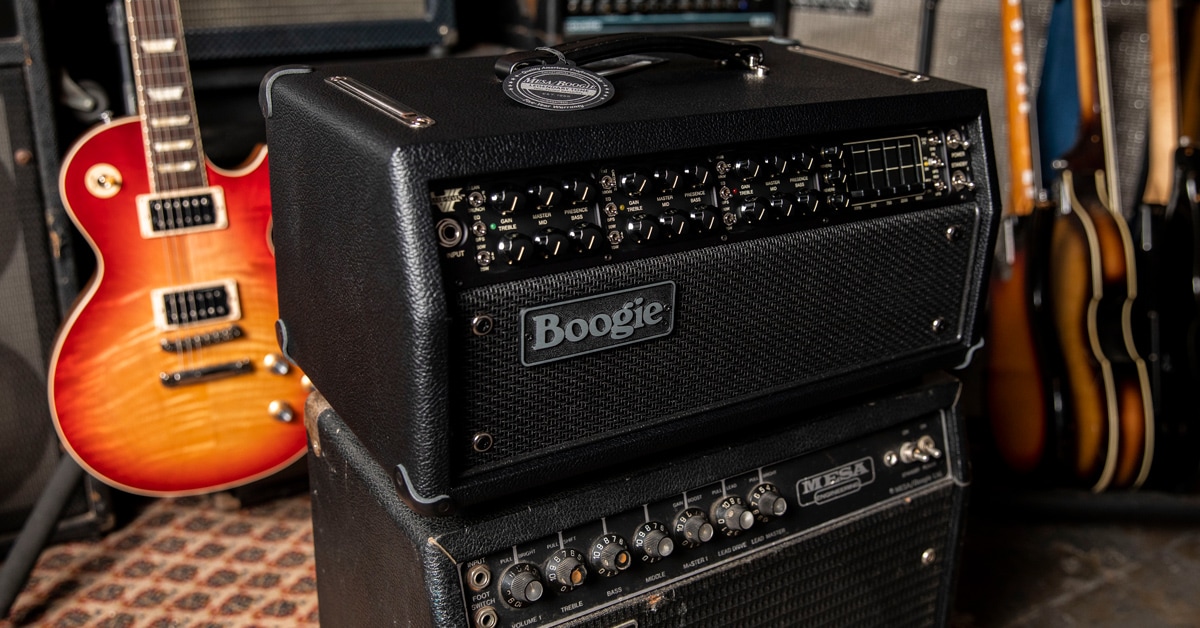Since Randall Smith started repairing and modifying amplifiers in San Francisco in the late 1960s, his creations and their descendants originated and refined the very concept of the boutique amplifier. From the first modified Fender Princeton Reverb—an amp which got its name from Carlos Santana’s comment, “Man, this amp really boogies.”—to the incredible versatility and sonic range of today’s offerings, amplifiers from MESA/Boogie have also helped define the concepts of what great guitar tone should be. With the recent release of the MESA/Boogie Mark VII, the company has yet again staked a claim that goes beyond mere innovation, directly to the heart of what a modern amp should be capable of. In our conversation with MESA Tone Lab Director Doug West, who has been with the company since the early 1980s, we had a chance to dig into the thought process and philosophy of why these amplifiers are on the “Mark.”
For an deeper dive into MESA/Boogie's current amp offerings, be sure to check out How to Choose the Best MESA/Boogie Guitar Amplifier.
You describe the Mark VII as being “designed new from the ground up.” What does that actually mean?
Doug West: “From the ground up” means we wanted to make tonal purity, simple operation and maximum portability the prime directives, putting a little less emphasis on including features that, while useful, might potentially introduce compromise in these areas. For example, and without going too deep, the Output and Solo on the previous Mark V stood close to this fine line, so we retired them for a simpler, more straightforward approach.
We also wanted to deliver a compendium of our best sounds, and all we’ve learned over the 54 years of designing high-performance tube amps, and ultimately, create a Mark that surpassed even our most revered prior models. At the same time, we hoped to open doors for those who might view our brand, or at least our Mark models, as intimidating, feature-laden or too comprehensive at the cost of incredible tone. Though we would never let that happen, as proven by the Mark V, it was a challenge we wanted to take on with the VII.
Add the flexibility, convenience and—here’s that bad word again—comprehensivenesss of our CabClone DI for direct recording and live cab-less applications; wrap it all up with MIDI control; include the stripped-down, repurposed space on the more compact front panel, and we couldn’t be happier with the way the VII turned out. And thankfully, the feedback, thus far anyway, is confirming we hit the intended mark.
Can you tell us about how this “from the ground up” ethos specifically affected your approach to the voicing of the amp?
That really meant focusing the lens even more tightly on each Mode. To be clear, it’s not that the Mark V didn’t. It did. But, we’ve designed and released a lot of amps since then, and we are always making new discoveries, learning toneful tricks and applying newfound secrets.
Our compass is always set for achieving purity and delivering “organic” tone and a feel that is inviting, freeing and inspirational. In the VII, we followed that guiding light to an even deeper level. We spent a lot of time referencing our favorite old designs and paid even closer attention to every detail, while at the same time including the things we’ve learned that can actually improve upon them. The Mark VII Mode in Channel 2 is new, yet it also benefits from lessons learned across all of our products over the decades.
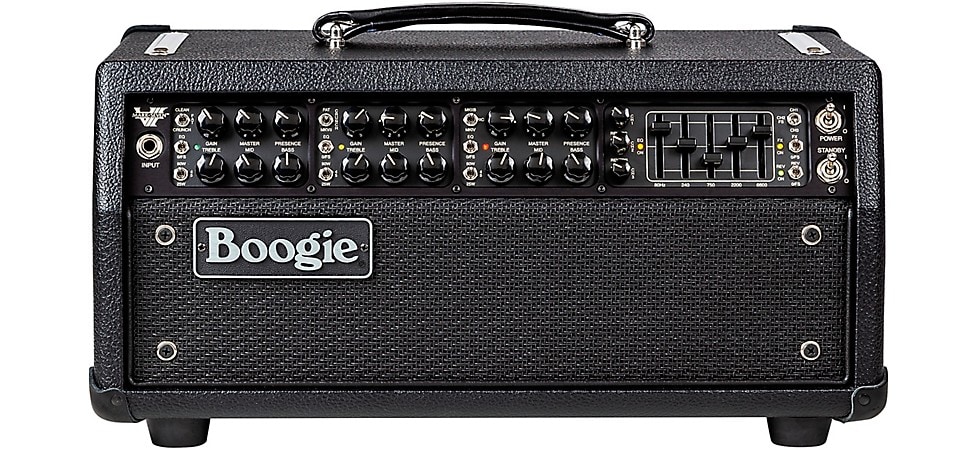
Speaking to all of those lessons learned, is there any significant step forward or development in the “tech” behind the Mark VII?
In terms of tech, the VII is an analog tube amp, so the basics remain the same basics pioneered back in the 1950s. However, the nuances throughout, and how that tech is applied to the individual circuits, is often new and exciting.
For example, the addition of the CabClone IR is relatively new for us, but really, it’s our partners at Two notes [Audio Engineering] who developed and delivered that. They also helped us capture our iconic cabinets and interface all in a simple way that matches the amp’s analog DNA.
In addition to CabClone tech you just referenced, there’s obviously been a lot of changes in guitar technology. How do you think that’s impacted player expectations of what an amp should deliver?
Well, a lot has changed, yet a lot hasn’t. For a tube amp like Mark VII, players expect nuanced, dynamically reactive sound and an inspiring, friendly feel. These attributes are what make tube amps irreplaceable, and in fact, musical instruments in their own right. Nothing else provides the symbiotic relationship between player and instrument—of which the amp is half of the equation for electric guitar—and a reciprocal feedback loop the way a great tube amp does—one where every nuance of input translates into an equally nuanced and emotionally satisfying response in output. This is our universe. We love creating in it, and thankfully, our fans, and guitarists on the whole, do too.
That said, much has changed in terms of interfacing requirements and the need for ease of application with these tube sounds going direct. That’s why we turned to the digital world for these requirements, with the inclusion of our CabClone IR. There was so much more we could achieve in terms of providing simplicity and accuracy in cabinetry going direct, that it made sense to include the best of both worlds. You’re still deriving your sound from, and shaping it with, a tube amp that contains the reactive elements and dynamic response and feel you go to one in the first place for. The end result is great sound, the same great feel and ultimate direct convenience. MIDI has been around, and we’ve used it as a control medium here and there in different models. Though many players don’t need it, there is no exposure to sonic compromise, so we thought it best to included it as well, for those who do.
The Mark VII contains nine distinct voicings across the three channels. Can you give us some more insight into what makes each of these voicings unique?
In the VII, we wanted to expand on the classic footswitchable Clean/Crunch/Lead thing that we forged back in late ’85 with the Mark IIIs, and, with that, lean a bit more toward the configurability we achieved in our current Fillmore Series. There, the two identical channels containing three identical modes allow you to roam the gain spectrum and configure the channels to suit your needs.
Since the VII has three channels, it was sufficient to duplicate only the Fat, Clean and Crunch modes over Channels 1 and 2. Hence, there is still the somewhat natural tendency to dedicate Channel 1 to cleans and Channel 2 to one of your gain sounds. But that is only one of the options this duplication and overlap in gain creates. A player can have two identical cleans of different volume levels, two differing cleans, a clean and a crunch sound, two crunch sounds of differing gain amounts, and so on through the many possibilities within the first two channels.
Sonically, these first two channels cover the “California Clean” domain, with a tight percussive version in Clean and a fuller, richer version in the duplicated Fat modes. These choices cover most anything one would ever need in terms of cleaner rhythm sounds. With the lower power options available at the flick of a switch, you can also push them and venture into “traditional amp” territory.
The gain spectrum begins with the Brit-influenced lower-gain Crunch mode in both Channels 1 and 2, and tops out with the new fire-breathing Mark VII mode that also leans Brit-voiced in Channel 2. While this hybrid “Mark-meets-Rectifier” sound is a dream tone for heavy music, it will also surprise with its lower gain settings. It cleans up surprisingly well for a high-gain mode and retains nice harmonic content and openness for clean-ish, edge-of-clipping work.
From there, we move on to Channel 3 and the Boogie collection of iconic sounds. First up, II-B has been tuned to work well across the gain spectrum, from almost-clean boosted sounds, through the mid-gain “smeared” region on up to pretty saturated smooth sustain. It’s decidedly a gain mode, yet throughout, the sound of the guitar is clearly defined, and the clarity maintained, so it can multi-task extremely well, even doubling as a “clean” of sorts. From there, Channel 3 enters what most view as classic Mark gain territory with the IIC+ and Mark IV modes, respectively. As before in the Mark V, they are faithful recreations that step up in gain as the mode switch is moved down. But here in the VII added scrutiny, old tricks and some new discoveries pay off hugely with improved versions of both these Boogie classics. More boldness, attack clarity and a three-dimensional, organic musicality emerge that many are telling us supercedes their favored now-vintage examples. Again, we keep learning and have included all the secrets uncovered over the years, so it’s not that surprising and we definitely feel the same.
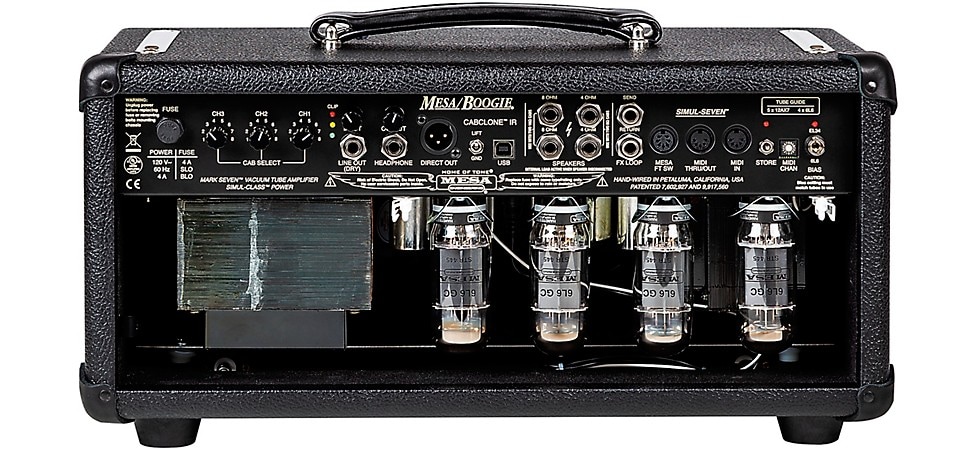
Speaking specifically to Channel 3, are these component-level recreations of the original circuits, or did you find other ways to get to that tone and overall performance?
These iconic modes are component-level recreations using layout architecture that is as close to the originals as is feasible considering the goal and the fact these reproductions have to fit within the overall package, alongside all the rest of the Mark VII’s circuits. And as mentioned, there are also improvements throughout that are a result of discoveries we’ve made over the decades since the originals were made.
What do you think is the unifying factor across the nine voicings that brings them together in a cohesive manner to emphasize this is a singular Boogie amp?
One perspective on that question might be that Boogies have been famous for—first with the Mark IIs—providing an incredible clean sound and a soaring lead voice. With the Mark III that morphed into providing an incredible clean, a footswitchable crunch (rhythm) sound and a soaring lead voice. Then, the Mark IV introduced greater control over these three characters. With the Mark V that was rewritten to include alternate clean and crunch sounds, along with multiple soaring, high-gain lead options. The VII takes that concept and expands it further while also scrutinizing the individual accuracy and overall musicality of the circuits themselves, to arrive at improved versions of them. Playing the V and VII side by side confirms this beyond a doubt for most players.
Another take on “Boogie traits” that tie the VII’s modes together could be their shared versatility and their musicality. These are sounds that, across all of the modes and their individual places on the gain ladder, can be used for any type of style or character. Some can stretch beyond their main focus better than others, for example the CRUNCH and II-B modes in Channels 2 and 3 respectively, with their broad gain reach, but they all share that chameleon-like versatility to some degree. Underneath it all is a balance, a musicality, an organic quality and a three-dimensionality that we always strive to achieve. In the Mark VII, we feel we’ve hit a new benchmark for these traits within all the versatility. In other words, it delivers incredible tone, but also all the rest of the important elements of a fine musical instrument that provide feedback and allow you to grow as a player and a musician.
One of the great things about Mark VII is the versatility of the power scaling. Can you explain how each setting changes how the power section works?
The 90-Watt Mode employs all four power tubes, with two operating in Class AB Pentode and two operating in Class A Pentode. The 45-Watt setting utilizes only the Class A Pair, also operating in Pentode, and the 25-Watt option stays with that motif–the two Class A tubes–but rewires them to operate in Triode.
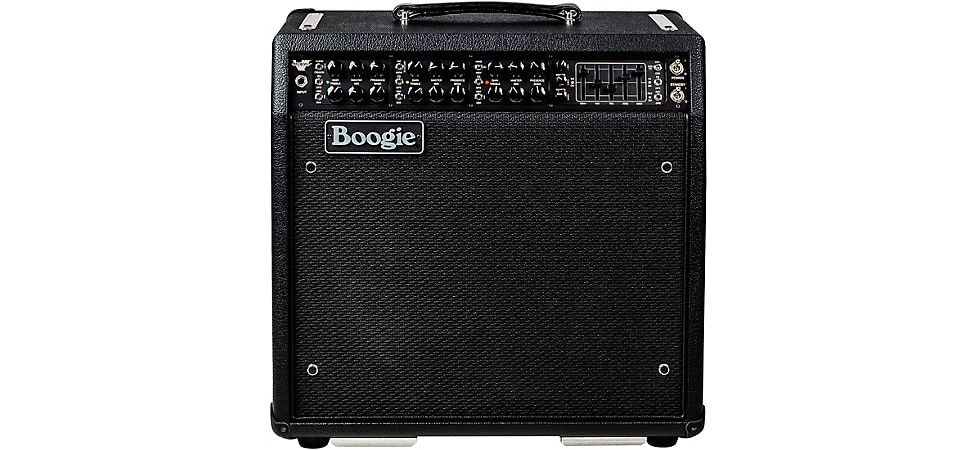
Outside of volume changes, how do those different power configurations change the overall tone and playing experience?
Sonically, this translates to the 90-Watt Mode being the boldest and most authoritative, highest-headroom option. This setting shines for the tight low-end response, say for heavy and/or detuned styles, as well as for higher-volume clean work and focused, cohesive, voice-like, gained-up, single-note soloing.
The 45-Watt Mode cuts the output power by roughly half and presents a brighter, more elastic, easier-to-clip character. This is great for blues and Americana styles where edge-of-clip chording and power overdrive is in character.
Finally, the 25-Watt option roughly halves overall power again, creating a warmer, more harmonically rich character, and a sweeter, softer top end that is even easier to push. It smears nicely, especially for chording.
There are volume differences throughout, as you mentioned, but the more musically important thing most will experience at reasonable playing volumes, is the character differences between these power options.
Let’s dig a bit deeper into the CabClone DI that you mentioned earlier. How does it expand upon a typical DI out?
The CabClone DI aboard the VII performs like most DIs in that it captures the sound of the amplifier, in this case both preamp and power amp, and applies it to the balanced XLR output, so that you can interface with a console (recording or live) for direct applications where miking up cabs is either not preferred or not possible. The VII incorporates a reactive load that is activated automatically when there is no cable connected to the speaker outputs. This protects the output transformer from an accidental no-load condition as well as greatly improving the sound, response and feel of the “silent” DI feature. You can use the DI “silently” with the eight cabinets provided, or you can upload custom ones as replacements. You can also combine the DI signal with a miked signal using cabinetry and mics of your choosing. Either way, the CabClone DI delivers pretty amazing performance with the sound and feel of your tube amp and most all the elements of a well-miked cab in the next room. And, in the case of the onboard MESA cabs, a very nice pro studio with all the dream gear.
The other application of the CabClone DI is its performance through headphones. Granted, it may not be the most affordable way to practice silently, but it is likely among the most rewarding and satisfying. It’s easy to get lost in the universe of great guitar sounds and inspiring, addictive tube-amp feel of the VII when experiencing the amp and eight MESA cabs through headphones. Adding a bit of delay and/or other spatial effects through the effects loop only adds to the enjoyment and sense of satisfaction. This application is often an afterthought when considering the CabClone DI’s attributes, but it really is a valuable benefit of having such great direct performance, the impact of which, on your practicing and playing, should not be overlooked.
Finally, the line-out output is an unprocessed (by the CabClone) signal, derived from the speaker output. It contains the raw signature of whatever sound is dialed up on the amp. This output is intended to feed an IR player/reader where you want the entire signature so that the IR reader/player can “stamp” the attributes of the sampled cabinet(s) and roll off or boost the frequencies associated with it. It’s not entirely unlike the slave output we fitted early Mark amps with, so it may also be used to feed effects processors or modelers as well. But, importantly, it won’t be the sound present at the XLR DI Output or live through your favorite cabs that have their own signature EQ curves.
What was the development process like with Two notes?
Working with Two notes was great! Their design team was very helpful in achieving our goals, and they have great respect for our work, and a genuine love for what we do. Many of them—especially founder Guillaume Pille—are players with their own MESA amps, so they get us, understand the nuances of tube amps and are driven to deliver them in full glory with their process. They helped us at every stage and guided our own longtime employee-turned-pro engineer in the capture process of our selected cabinets. They also worked diligently alongside us throughout our lengthy R&D journey to make sure the inclusion of their circuitry was amenable to the overall design we had for the VII and could be integrated in a way that felt like MESA and would be familiar to our fans.
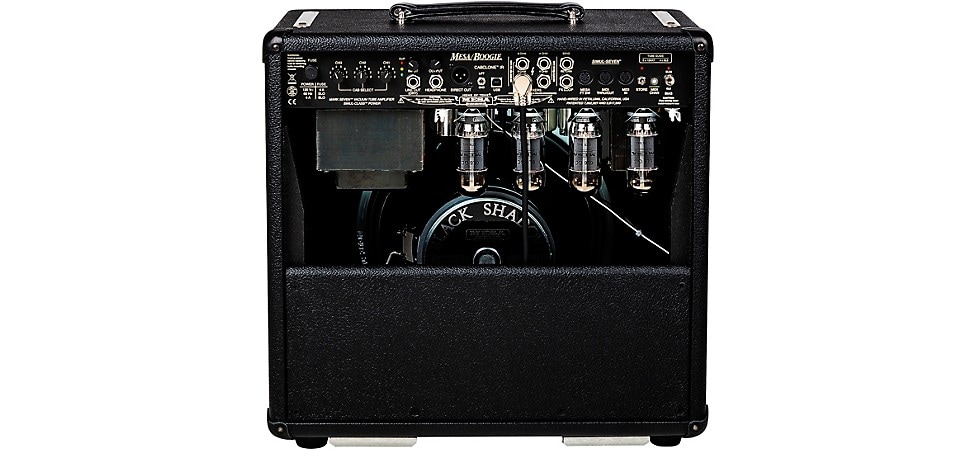
Can you give us a little more insight into which cabinets are available with CabClone and what type of sound they offer?
The eight cabinets repeated in the same sequence on all three channel’s Cab Select rotary control are as follows:
Cab 1: Rectifier 4x12" Standard: This cab offers giant sound, huge low end and a pronounced mid scoop.
Cab 2: Rectifier 4x12" Traditional: This cab delivers big sound, a tight low end and great percussive attack.
Cab 3: Rectifier 2x12" Horizontal: This cab projects a wide 3D sound with huge low end and a mild mid scoop.
Cab 4: Rectifier 1x12”: It has a warm, thick voice with ample low end a focused top end. It’s a great solo voice.
Cab 5: 1x12" Thiele: This cab is ported and has a nice low end, a focused midrange and a slightly reduced top end.
Cab 6: Lone Star 2x12”: This cab has an open back with a spatial quality. It has a nice low end, some mid scoop and a warm top end.
Cab 7: Lone Star 1x12" 23”: This cab has an open back, spatial quality, nice low end, balanced mids, warm top end.
Cab 8: A 1x12" 23”: with an alnico speaker, This cab has a sweet, open-back ,“vintage-voiced” response that’s great for cleans and bluesy, traditional and Americana sounds.
For someone new to the MESA/Boogie world, which channel and mode would you recommend they check out first to get a feel for what the Mark VII is all about?
That’s a tough question! It’s a bit like attempting to describe a love interest by outlining only one of their special qualities. I think a better way to look at a “first date” with the Mark VII might be this: What three sounds would you most like to have instantly at your fingertips (or rather toe-tips) first? That perspective is like dining with the person of interest for an evening, where you can learn a bit more about their depth of personality.
Many guitarists would like to have a great clean sound, a nice in-between clipped or overdrive sound and a lead sound with a little more overdrive, girth and sustain. With this basic setup in mind, I would suggest a good “first date” might be:
Channel 1 set to FAT CLEAN with the Gain knob set at 12:30
Channel 2 set to CRUNCH with the Gain knob set at 1:00
Channel 3 set to Mark IV mode with the Gain knob set at 1:30
The Tone Controls and PRESENCE can be set to taste with these two caveats:
Channel 2: Treble and Presence at 11:00
Channel 3: Mid at 9:00, Bass at 10:00 and Presence at 9:00–10:00.
For a great overall power/wattage choice, we suggest starting with all three channels set to 90 watts regardless of the playing volume needed, as this Simul-Class setting delivers the fullest, richest character and most dynamic response throughout the different modes and channels.
Lastly, the graphic EQ is most appropriate for the IIC+ and IV modes in Channel 3. The classic “V” setting quickly showcases its power and flexibility, as well as shapes the Boogie sound most associated with the rock icons that have utilized it for their tone.
While you’re there in the EQ window, you can switch on the reverb, often a nice touch, and set each channel to the desired mix level with the three stacked reverb controls.
This collection of three popular sounds will provide a basic understanding of the options over a fairly wide range of gain possibilities, however it’s still mostly a one-dimensional sampling of the sounds within the VII. The amp can be configured to provide an almost limitless set of possibilities for three footswitchable sounds, and it’s really just a matter of how you wish to dedicate the channels to your needs. From there you should set them according to your style, your instrument of choice and your gain requirements with the modes and controls.
The Mark VII is the easiest to dial of all Mark amplifiers we’ve built, thanks to its intuitive layout, separate channels and dedicated controls. It can be sampled quickly with great results. However, like any fine instrument builder, our goal with the VII is to provide many years of inspiration, exploration and enjoyment that lasts long after the honeymoon period. The real fun–and reward–comes in the long-term experience, and the benefits of playing it while you grow as a player throughout your musical journey.










